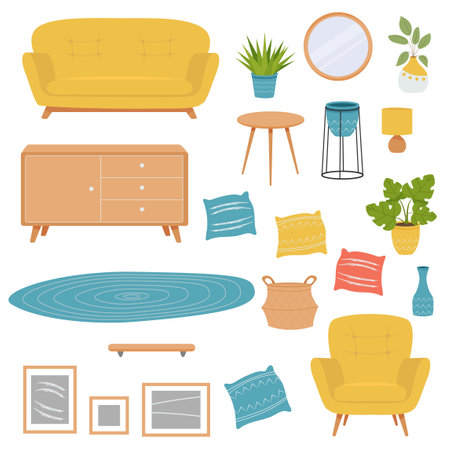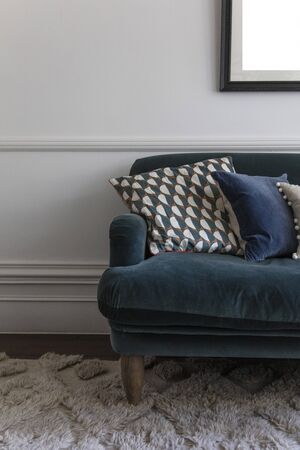Celebrating Heritage: The Role of Textiles in Period Homes
Fabrics and soft furnishings have long played a pivotal role in shaping the distinctive atmosphere of British period homes. From the refined symmetry of Georgian drawing rooms to the plush intimacy of Victorian parlours, textiles have served not only as practical necessities but also as markers of taste, status, and evolving design sensibilities. In the grand estates and townhouses of 18th-century Britain, opulent draperies, damasks, and chintzes provided an essential backdrop for social gatherings, their patterns and textures reflecting both cosmopolitan influences and local craftsmanship. As the 19th century ushered in new industrial possibilities, homes became even more richly layered: velvet curtains framed tall sash windows, embroidered cushions adorned settees, and hand-knotted rugs introduced warmth underfoot. These choices were never arbitrary; they echoed the values and aspirations of their era, blending comfort with formality. Today, when restoring or furnishing a period property, a thoughtful selection of textiles remains central to honouring its heritage—evoking bygone grandeur while offering tactile delight and visual richness that is unmistakably British.
2. Quintessential British Fabrics: Velvet, Damask, and Beyond
When it comes to period homes in the UK, few elements evoke opulence and heritage quite like the nation’s iconic textiles. These fabrics—rooted in centuries of craftsmanship and social history—have adorned stately drawing rooms, grand staircases, and intimate boudoirs across generations. To truly appreciate their enduring allure, it’s essential to explore their origins, signature patterns, and the distinctive atmosphere they impart to traditional interiors.
The Origins of Classic British Textiles
British textile heritage is a tapestry woven from diverse influences, including imported luxury fibres and homegrown ingenuity. During the Georgian and Victorian eras, advancements in weaving technology enabled an explosion of intricate patterns and lavish textures. The following table highlights some of the most celebrated fabrics:
| Fabric | Origin | Typical Patterns | Period Popularity |
|---|---|---|---|
| Velvet | Medieval Italy, adopted by British aristocracy | Plain, embossed, or patterned (floral/arabesque) | Tudor onwards; peak in Victorian era |
| Damask | Silk Road trade, popularised in Jacobean England | Reversible floral or foliate motifs | Jacobean through Regency periods |
| Brocade | Asia & Europe; embraced by British nobility | Raised designs with metallic threads | Georgian and Victorian eras |
| Chintz | Indian import; adapted for English tastes | Crisp cottons with floral prints | 18th-century country houses |
The Enduring Appeal of Heritage Fabrics
What makes these textiles so timeless? At heart, it’s their ability to combine sumptuous tactility with visual drama. Velvet’s deep pile absorbs light, creating a sense of depth and warmth—ideal for heavy curtains or a statement armchair. Damask offers subtle sophistication, its intricate designs shifting gently with changing light. Brocade’s ornate shimmer was historically a mark of wealth and taste, making it perfect for feature cushions or wall panels.
A Modern Take on Tradition
While these fabrics were once exclusive to the upper echelons of society, today’s period homes blend authenticity with accessibility. Contemporary designers reinterpret classic motifs in new colourways or sustainable fibres. This balance between heritage and innovation ensures that quintessential British fabrics remain central to opulent interiors—offering both a nod to the past and a vibrant presence in modern living spaces.

3. Curtains, Drapes, and Blinds: Framing the British Window
Window treatments have long held a place of reverence in British period homes, serving as both functional necessities and expressive statements of style. The tradition of framing windows with sumptuous curtains or precise blinds speaks to a distinctly British approach to comfort and privacy—a subtle negotiation between letting in the soft northern light and preserving the intimacy of domestic life. In grand Georgian or Victorian residences, heavy damask or velvet drapes, often finished with ornate tassels and pelmets, were not only status symbols but also practical barriers against draughts. Such choices reflect an era when opulence was intertwined with utility, and where every fold and pleat signalled a household’s appreciation for craftsmanship.
Traditional Styles: Echoes of Heritage
Each period brings its own vocabulary of window dressing. Regency homes might favour elegant swags and tails in silk or fine cotton, echoing classical restraint, while Edwardian interiors embrace lighter voiles and lace, allowing filtered daylight to illuminate intricate mouldings and wallpapers. These styles are more than just aesthetic preferences; they are visual cues that anchor a home within its historical context. For many British homeowners, respecting these traditions is an act of cultural stewardship—a way of keeping the spirit of the house alive while gently adapting it to modern sensibilities.
Fabric Choices: Texture and Tone
The choice of fabric plays a pivotal role in setting the mood within period interiors. Rich velvets or brocades lend a sense of grandeur to high-ceilinged drawing rooms, while chintz or linen offers a breezier, more informal air suitable for country cottages or sunrooms. Colours often draw on palettes inspired by the English landscape—deep greens, muted golds, or floral pastels—creating continuity between indoors and out. The tactile qualities of these fabrics invite touch and convey warmth, reinforcing the welcoming ethos that underpins much of British domestic culture.
Cultural Cues in Design Decisions
Beneath these stylistic choices lies a web of subtle cultural meanings. The decision to layer sheers beneath heavier curtains may speak to the British penchant for privacy without sacrificing light. Similarly, choosing wooden Venetian blinds or Roman shades can signal a desire for simplicity paired with understated elegance—a nod to both practicality and taste. Ultimately, window treatments in period homes do more than dress a window; they reflect an ongoing dialogue between history, environment, and personal identity, encapsulating what it means to dwell beautifully within Britain’s architectural heritage.
4. Cushions, Throws, and Upholstery: Layering Luxurious Comfort
When it comes to period homes, layering soft furnishings is not merely a question of comfort; it is an art form that pays homage to the property’s heritage while introducing warmth and elegance. Cushions, throws, and upholstered furniture serve as tactile bridges between opulence and authenticity, allowing homeowners to weave layers of texture, colour, and historical reference throughout their interiors.
The Art of Soft Layering
Layering begins with thoughtful selection—choosing cushions in plush velvets or intricate brocades reminiscent of Victorian or Georgian parlours. Throws in pure wool or cashmere draped casually over a chaise longue evoke both grandeur and relaxation. Period-appropriate upholstery fabrics such as damask, chintz, or Jacobean linen can transform a simple armchair into a statement piece that anchors the room in its era.
Blending Texture and Tone
A successful scheme respects the home’s original architectural details—think decorative cornices or panelled walls—by selecting soft furnishings that echo these features without overpowering them. The interplay of patterns, from classic florals to subtle stripes, can be coordinated through a palette inspired by the period’s traditional hues: deep crimsons, sage greens, or muted golds.
Soft Furnishing Layering Guide
| Element | Recommended Fabrics | Historical Reference |
|---|---|---|
| Cushions | Velvet, Brocade | Victorian/Edwardian drawing rooms |
| Throws | Wool, Cashmere | Georgian country houses |
| Upholstery | Damask, Chintz, Linen | Regency salons, Jacobean halls |
Practical Elegance: Everyday Use in a Heritage Setting
Bespoke cushions piped with contrast trim or hand-embroidered motifs nod to artisanal British craftsmanship. Throws folded at the foot of an antique bed offer both visual richness and practical warmth during chilly UK evenings. Upholstered window seats adorned with layers of textiles invite lingering moments with a book while showcasing the window’s historic leaded lights.
In essence, the strategic layering of soft furnishings not only elevates comfort but also acts as a respectful dialogue between present-day living and the timeless allure of Britain’s architectural past.
5. Balancing Authenticity with Modern Comfort
Integrating period-appropriate fabrics and soft furnishings into a modern British home is both an art and a practical challenge. While the allure of damasks, silks, and brocades speaks to the opulence of Georgian drawing rooms or Victorian parlours, daily life in the twenty-first century requires comfort and functionality. The key lies in thoughtful selection and clever blending.
Honouring Heritage through Fabric Choices
Start by identifying textiles that resonate with your homes architectural era. For Regency properties, consider striped silks or delicate chintz; for Edwardian townhouses, heavier velvets and tapestries evoke an authentic mood. However, its vital not to let historical accuracy override usability—especially when it comes to high-traffic areas or family spaces.
Modern Materials with a Period Look
Fortunately, many contemporary fabric houses offer collections that mimic traditional weaves but feature modern blends. These fabrics deliver the visual richness of heritage textiles while offering stain resistance, easier cleaning, and greater durability—crucial for today’s busy households.
Layering for Versatility and Comfort
Layering is another strategy favoured in British interiors: combine heavy drapes or pelmets (with thermal linings for insulation) alongside lightweight sheers for privacy without sacrificing light. Use cushions upholstered in traditional motifs atop modern sofas, or opt for throws that echo historical patterns yet are crafted from machine-washable fibres.
Practical Details for Everyday Living
Dont overlook practical considerations such as flame retardancy, UV protection, or allergy-friendly materials—features seldom found in original period textiles but essential in the contemporary home. By marrying these innovations with classic aesthetics, you create a home that feels both timeless and tailored to current needs.
Ultimately, balancing authenticity with modern comfort means making discerning choices—preserving the essence of Britain’s decorative past while ensuring your interiors support present-day living. This approach honours tradition without becoming a museum piece, resulting in spaces that are as inviting as they are evocative.
6. Sourcing and Care: Finding the Right Textiles for British Period Homes
When it comes to furnishing a British period home with sumptuous fabrics and soft furnishings, sourcing the right textiles is both an art and a journey through history. High-quality materials—be they genuine antiques, bespoke commissions, or faithful reproductions—form the backbone of an opulent interior rooted in heritage. For those seeking authenticity, antique fairs, specialist dealers, and reputable auction houses across the UK offer rare finds such as Victorian damasks or Georgian silks, each bearing the patina and charm of age.
Bespoke and Reproduction Textiles
If sourcing true antiques proves elusive or impractical, Britain’s legacy of textile craftsmanship offers ample alternatives. Many historic mills—particularly in regions like Lancashire and Yorkshire—still produce fabric on traditional looms using original patterns. Commissioning bespoke pieces from these artisans allows homeowners to tailor colours, weaves, and motifs to suit their specific period aesthetic, ensuring both exclusivity and authenticity. Reputable reproduction houses also offer meticulously researched collections that echo Regency stripes or Arts & Crafts embroideries, bridging the gap between historical fidelity and contemporary durability.
Choosing Wisely: Quality Over Quantity
Selecting the right textile involves more than aesthetics; quality is paramount. Natural fibres such as wool, linen, and silk have long been favoured in British homes for their resilience and timeless appeal. When choosing upholstery or drapery fabrics, look for dense weaves, hand-finished details, and dye-fastness—all indicators of superior craftsmanship that will stand up to daily use while retaining their beauty.
Preservation and Care: Ensuring Longevity
Once you have invested in fine fabrics, preservation becomes essential to maintain their opulence for generations. Regular gentle vacuuming with a brush attachment helps prevent dust accumulation without abrading delicate fibres. For antique textiles or intricate embroidery, consult a professional conservator for specialist cleaning methods. Sunlight can fade even the most robust dyes over time; consider using interlined curtains or UV-filtering window film to shield precious draperies from harsh rays. Lastly, rotate cushions and throws periodically to ensure even wear—an old but effective British habit ensuring heirlooms remain vibrant for years to come.
In essence, thoughtful sourcing paired with meticulous care allows British period homes not only to celebrate their storied past through luxurious textiles but also to preserve these treasures as living testaments to craftsmanship and style.

